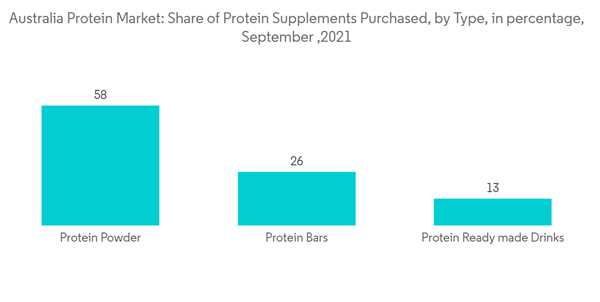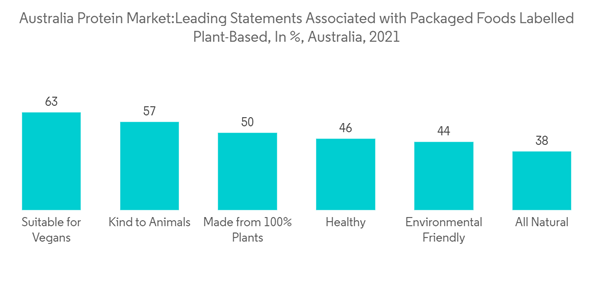The Australia protein market is expected to grow from USD 230.14 million in 2024 at a CAGR of 4.04% in the upcoming five years.
This product will be delivered within 2 business days.
Key Highlights
- Animal-derived proteins such as collagen, keratin, elastin, silk protein, milk protein, egg protein, lanolin, honey, and caviar extract are extensively used in the manufacturing and processing of beauty and personal care products in Australia. These ingredients tend to offer skincare and haircare benefits such as improving skin lasticity, reducing wrinkles, enhancing shine, strengthening hair, and providing moisturization, resulting in increasing demand for animal-based proteins in the beauty and personal care industry.
- As Australia exports a significant amount of beauty and personal care products to New Zealand, China, the United States, and other countries, the demand for animal protein in the industry is expected to increase in the coming years. For instance, According to the Australian Bureau of Statistics, Australia exported beauty and personal care products worth USD 148.73 million in 2021.
- Animal protein is extensively used in the production of animal feeds such as poultry feed, pet foods, and other animal feed products that are extensively consumed across the country. For instance, poultry feed incorporates animal protein sources like fish meal, poultry meal, and meat and bone meal to support growth, muscle development, and egg production in chickens and ducks. With increasing poultry consumption in the country, the demand for animal protein in the poultry industry is expected to increase in the country. For instance, According to the Organization for Economic Co-operation and Development (OECD), per capita consumption of poultry in Australia stood at 46.12 kg in the year 2022. Additionally, animal protein is also a key ingredient in pet food formulations, supporting the growth, energy, and health of dogs, cats, and other pets. Swine feed often includes animal protein sources like dried whey, fish meal, and plasma proteins to enhance piglet growth and health. These factors tend to increase the demand for protein in the animal feed industry in Australia.
Australia Protein Market Trends
Increasing application of protein in various industries
- Protein ingredients are getting traction in the country with the increase in acceptance of natural, health-benefitting concepts. The application of protein-based ingredients into convenience foods and beverages is gaining importance in the market for their ease of consumption properties.
- Consumers prefer to eat food products that contain more protein content and fewer carbs, encouraging the manufacturers in the market to incorporate protein-rich content in processed foods such as protein bars, drinks/shakes, and others. For instance, Elite supplements company operating in Australia is offering protein bars infused with whey protein, which are gluten-free and contain high fiber content.
- Additionally, with more consumers focusing on health and physical fitness, the demand for protein-based supplements is gaining importance in the market for their muscle-building and performance-enhancement properties. With more young consumers focusing on fitness, the demand for supplements among young consumers is increasing over time.
- For instance, the Australian Sports Commission revealed that about 49.9% and 45.1% of the age groups 18-24 and 25-35, respectively, are using fitness clubs and sports centers in 2022. With more consumers involved in fitness, the demand for protein-rich supplements is gaining importance in the market.
Increasing inclination towards Plant Protein
- The rising inclination towards plant protein among the consumers in the market is subjected to the increasing occurrence of health complications such as gluten intolerance and lactose intolerance. Consumers are shifting towards plant-based protein products from animal-sourced protein to avoid consumption of allergen-based foods.
- Plant proteins sourced from soy, almond, coconut oats, and others are becoming popular among lactose-intolerant consumers, resulting in increasing demand for plant protein-incorporated foods.
- Owing to the demand, manufacturers in the market are focusing on introducing products that contain plant-based protein products to cater to the demand in Australia. In September 2022, All G Foods Company, operating in Australia, launched its new plant-based protein products brand, Bloom Providore.
- The brand offers plant-based burgers loaded with proteins that imitate the taste and texture of beef, lamb, pork, chicken, and other meat products. Additionally, supplements that are made from plant materials are witnessing a high demand for their natural origin, and consumers tend to believe that these products are comparatively healthy and environmentally friendly.
Australia Protein Industry Overview
The Australian protein market is moderately consolidated, with the top five companies occupying the majority of the market. The major players in this market are Archer Daniels Midland Company, DuPont de Nemours Inc, Fonterra Co-operative Group Limited, Freedom Foods Group Limited, and Kerry Group plc. Expanding the product offerings and areas of application of proteins were a few of the major competitive strategies adopted by the players in the market.Additional Benefits:
- The market estimate (ME) sheet in Excel format
- 3 months of analyst support
This product will be delivered within 2 business days.
Table of Contents
1 Introduction
4 MARKET DYNAMICS
5 Market Segmentation
6 Competitive Landscape
Methodology

LOADING...










